Properties of spontaneous Ca2+ transients recorded from interstitial cells of Cajal-like cells of the rabbit urethra in situ
- PMID: 17615099
- PMCID: PMC2277017
- DOI: 10.1113/jphysiol.2007.136697
Properties of spontaneous Ca2+ transients recorded from interstitial cells of Cajal-like cells of the rabbit urethra in situ
Abstract
Interstitial cells of Cajal-like cells (ICC-LCs) in the urethra may act as electrical pacemakers of spontaneous contractions. However, their properties in situ and their interaction with neighbouring urethral smooth muscle cells (USMCs) remain to be elucidated. To further explore the physiological role of ICC-LCs, spontaneous changes in [Ca(2+)](i) (Ca(2+) transients) were visualized in fluo-4 loaded preparations of rabbit urethral smooth muscle. ICC-LCs were sparsely distributed, rather than forming an extensive network. Ca(2+) transients in ICC-LCs had a lower frequency and a longer half-width than those of USMCs. ICC-LCs often exhibited Ca(2+) transients synchronously with each other, but did not often show a close temporal relationship with Ca(2+) transients in USMCs. Nicardipine (1 microm) suppressed Ca(2+) transients in USMCs but not in ICC-LCs. Ca(2+) transients in ICC-LCs were abolished by cyclopiazonic acid (10 microm), ryanodine (50 microm) and caffeine (10 mm) or by removing extracellular Ca(2+), and inhibited by 2-aminoethoxydiphenyl borate (50 microm) and 3-morpholino-sydnonimine (SIN-1; 10 microm), but facilitated by increasing extracellular Ca(2+) or phenylephrine (1-10 microm). These results indicated that Ca(2+) transients in urethral ICC-LCs in situ rely on both Ca(2+) release from intracellular Ca(2+) stores and Ca(2+) influx through non-L-type Ca(2+) channel pathways. ICC-LCs may not act as a coordinated pacemaker electrical network as do ICC in the gastrointestinal (GI) tract. Rather they may randomly increase excitability of USMCs to maintain the tone of urethral smooth muscles.
Figures

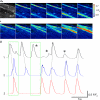
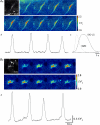
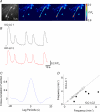
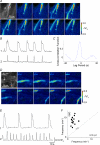

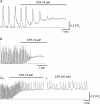



Similar articles
-
Ca2+ signalling in mouse urethral smooth muscle in situ: role of Ca2+ stores and Ca2+ influx mechanisms.J Physiol. 2018 Apr 15;596(8):1433-1466. doi: 10.1113/JP275719. J Physiol. 2018. PMID: 29383731 Free PMC article.
-
Role of InsP3 and ryanodine receptors in the activation of capacitative Ca2+ entry by store depletion or hypoxia in canine pulmonary arterial smooth muscle cells.Br J Pharmacol. 2007 Sep;152(1):101-11. doi: 10.1038/sj.bjp.0707357. Epub 2007 Jun 25. Br J Pharmacol. 2007. PMID: 17592501 Free PMC article.
-
Heterogeneous CPA sensitivity of spontaneous excitation in smooth muscle of the rabbit urethra.Br J Pharmacol. 2006 Jun;148(3):340-9. doi: 10.1038/sj.bjp.0706729. Br J Pharmacol. 2006. PMID: 16582935 Free PMC article.
-
Origin of spontaneous rhythmicity in smooth muscle.J Physiol. 2006 Jan 1;570(Pt 1):23-8. doi: 10.1113/jphysiol.2005.098376. Epub 2005 Oct 20. J Physiol. 2006. PMID: 16239271 Free PMC article. Review.
-
Role of Ano1 Ca2+-activated Cl- channels in generating urethral tone.Am J Physiol Renal Physiol. 2021 Apr 1;320(4):F525-F536. doi: 10.1152/ajprenal.00520.2020. Epub 2021 Feb 8. Am J Physiol Renal Physiol. 2021. PMID: 33554780 Review.
Cited by
-
Smooth muscle cell calcium activation mechanisms.J Physiol. 2008 Nov 1;586(21):5047-61. doi: 10.1113/jphysiol.2008.160440. Epub 2008 Sep 11. J Physiol. 2008. PMID: 18787034 Free PMC article. Review.
-
The intracellular Ca2+ release channel TRPML1 regulates lower urinary tract smooth muscle contractility.Proc Natl Acad Sci U S A. 2020 Dec 1;117(48):30775-30786. doi: 10.1073/pnas.2016959117. Epub 2020 Nov 16. Proc Natl Acad Sci U S A. 2020. PMID: 33199609 Free PMC article.
-
Ca2+ transients in ICC-MY define the basis for the dominance of the corpus in gastric pacemaking.Cell Calcium. 2021 Nov;99:102472. doi: 10.1016/j.ceca.2021.102472. Epub 2021 Sep 10. Cell Calcium. 2021. PMID: 34537580 Free PMC article.
-
Role of perinuclear mitochondria in the spatiotemporal dynamics of spontaneous Ca2+ waves in interstitial cells of Cajal-like cells of the rabbit urethra.Br J Pharmacol. 2010 Oct;161(3):680-94. doi: 10.1111/j.1476-5381.2010.00902.x. Br J Pharmacol. 2010. PMID: 20880405 Free PMC article.
-
Functions of ICC-like cells in the urinary tract and male genital organs.J Cell Mol Med. 2010 Jun;14(6A):1199-211. doi: 10.1111/j.1582-4934.2010.01043.x. Epub 2010 Feb 24. J Cell Mol Med. 2010. PMID: 20184664 Free PMC article. Review.
References
-
- Andersson K-E, Wein AJ. Pharmacology of the lower urinary tract: basis for current and future treatments of urinary incontinence. Pharmacol Rev. 2004;56:581–631. - PubMed
-
- Bilmen JG, Wootton LL, Godfrey RE, Smart OS, Michelangeli F. Inhibition of SERCA Ca2+ pumps by 2-aminoethoxydiphenyl borate (2-APB). 2-APB reduces both Ca2+ binding and phosphoryl transfer from ATP, by interfering with the pathway leading to the Ca2+-binding sites. Eur J Biochem. 2002;269:3678–3687. - PubMed
-
- Bridgewater M, Macneill HF, Brading AF. Regulation of urethral tone in pig urethral smooth muscle. J Urol. 1993;150:223–228. - PubMed
Publication types
MeSH terms
Substances
LinkOut - more resources
Full Text Sources
Miscellaneous

